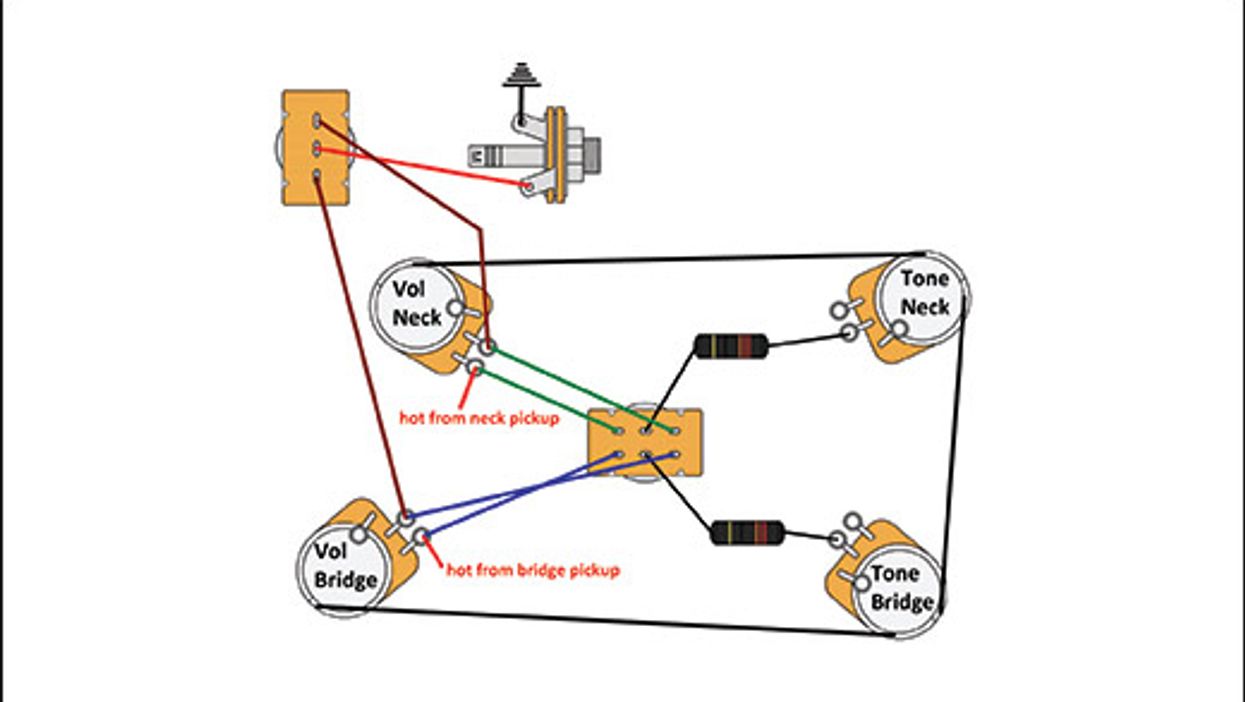In the decade I've been writing Mod Garage, we've explored how to hot-rod Teles and Strats with “Gibson '50s wiring," yet never addressed the guitar that gave us this wiring—the Les Paul. It's time to remedy this, but with a twist: I'll show you how to create a switchable circuit for your Les Paul that offers both the '50s wiring and the modern wiring Gibson uses today.
What is '50s wiring? Sometimes called “vintage wiring," it's how Gibson configured all their electric guitars in the late '50s, including the coveted 'burst Les Pauls. Electronically, there's nothing extraordinary going on: '50s wiring simply connects the tone pot to the output of the volume pot (the middle lug), instead of connecting the tone pot to the volume pot's input, which is how Gibson does it now.
Sound can be hard to describe, but with '50s wiring, the guitar's tone gets stronger and more transparent, and notes seem to “bloom" after being played. Also, when you roll back the volume, you experience less treble loss than on a typical modern Les Paul. In this vintage configuration, the volume and tone controls are less prone to having hot spots—they respond more smoothly and evenly, and it's easier to clean up an overdriven amp by simply rolling back the volume on your guitar a bit. The tone and volume controls interact with each other, a trait you may recognize from some early Fender tube amps. When you change the volume, the tone changes a little as well, and vice versa. This may seem strange at first, but it only takes a few minutes to get used to it.
Best of both worlds. Instead of having to choose between modern or vintage wiring, why not have either available at the flip of a switch? All you need is a 2PDT (on-on) switch, which can be a stealthy push-pull or push-push pot (where this 2PDT switching matrix is standard), or an additional mini toggle switch. Whatever switch you choose, you'll be able to flip from '50s to modern wiring for both pairs of volume and tone controls.
Check out the wiring schematic (Fig. 1). Notice how one side of each tone cap is connected to the 2PDT switch. This is what makes it possible to connect them either to the volume pots' input (modern wiring) or output ('50s wiring), via the two green and blue wires.
In closing, let me anticipate two possible questions about this dual-voice mod:
“Hey Dirk, the '50s wiring diagrams on the internet look different from your diagram at the tone pot section."
That's true. Gibson connected the output (middle lug) of the tone pots to ground. There are two good reasons I decided to go a different way for this mod. First, in a Les Paul the tone pot is wired as a variable resistor, so this solution is electrically equivalent with absolutely no differences in tone and performance. Second, you'd need a 6PDT on-on switch to add ground switching to the tone pots. They're expensive, bulky, and not available as push-pull or push-push pots. So why complicate matters?
“When rolling back the volume in the '50s wiring mode, I have way too much high end."
If this is a problem, chances are you have what's called a “treble-bleed network" connected to your volume pots. This network usually comprises a capacitor with a resistor piggybacked in parallel between the input and output lugs of each volume pot. Though this works well with the modern wiring, it will be too much in '50s wiring mode. (Note: If you have a Les Paul with modern wiring and no treble-bleed networks, you can simply skip the following material—it doesn't pertain to you.)
The '50s wiring makes treble-bleed networks obsolete for most players, because the treble loss is much less compared to standard wiring and it follows a completely different curve. Vintage wiring works best with audio taper pots, preferably with a 60:40 or 70:30 ratio. Smaller ratios (like 80:20 or 90:10) will limit the inherently smooth response of vintage wiring and result in an “on-off" or “bright-dull" problem when using the controls.
What to do? You'll need to compromise: You can remove the treble-bleed networks and live with the treble loss in modern wiring mode. Or you can leave the treble-bleed networks untouched and live with too much high end in '50s mode. It's possible to route the treble-bleed networks through an additional switch, so you could toggle them in or out, depending on the wiring mode you choose. But that gives you one more switch to engage and requires a lot of thinking—no fun. You could configure a 4PDT switch to throw the treble-bleed network in or out when choosing the wiring mode, but again such switches are big, expensive, and not available as push-pull or push-push pots.
That's it! Next month we'll discover how to build a professional pickup phase tester for only a few bucks. Until then ... keep on modding!















![Rig Rundown: Russian Circles’ Mike Sullivan [2025]](https://www.premierguitar.com/media-library/youtube.jpg?id=62303631&width=1245&height=700&quality=70&coordinates=0%2C0%2C0%2C0)




